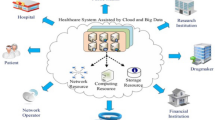Abstract
To improve the management ability of patient information and establish a feasible electronic medical record (EMR) management system, combined with the characteristics of e-commerce, the EMR system is established. Moreover, based on Skip-gram algorithm, the word database of EMR is segmented and extracted. First, the data in the EMR are preprocessed to extract the specific information from the EMR. Then, the data preprocessed based on Skip-gram algorithm are analyzed and processed to realize the automatic naming, recognition and annotation of EMR. The experimental results show that the precision, recall and F1-measure of Skip-gram model are 87.83%, 87.25% and 87.54%, respectively, which are better than those of RNN model. Therefore, Skip-gram algorithm is feasible and effective in the construction of EMR system. This exploration provides a reference for data processing of EMR system.






Similar content being viewed by others
References
Angoff GH, O’Connell JJ, Gaeta JM, Nueces DDL, Lawrence M, Nembang S, Baggett TP (2018) Electronic medical record implementation for a healthcare system caring for homeless people. Jamia Open 1:1
Aydin ZA (2020) srailoullar’na Yneltilen nek Kesme Emrinin Fail-i Mehul Cinayetlerin zümlenmesiyle likisi: Kur’n ve Tevrat Merkezli Bir nceleme. Abant zzet Baysal niversitesi lahiyat Fakültesi Dergisi 8(1):58–75
Bankapur S, Patil N (2020) Enhanced protein structural class prediction using effective feature modeling and ensemble of classifiers. IEEE/ACM Trans Comput Biol Bioinform 99:1
Bunyamin H, Heriyanto SN, Sulistiani L (2019) Topic clustering and classification on final project reports: a comparison of traditional and modern approaches. IAENG Int J Comput Sci 46(3):506–511
Du X, Yan J, Zhang R, Zha H (2020) Cross-network Skip-gram embedding for joint network alignment and link prediction. IEEE Trans Knowl Data Eng 99:1
Guichelaar T, Van Erp EA, Hoeboer J, Noortje S, Els V, Daan P, Willem L (2018) Diversity of aging of the immune system classified in the cotton rat (Sigmodon hispidus) model of human infectious diseases. Dev Comp Immunol 82:39–48
Hadifar A, Momtazi S (2018) The impact of corpus domain on word representation: a study on Persian word embeddings. Lang Resour Eval 52(4):997–1019
Huang Y, Ni W, Hong L, Fei X, Wei L, Chen H (2019) Study on structured patient feature representation method based on Skip-gram word embedding algorithm. Bjing Biomed Eng 38(6):568–574 ((604))
Islam SMA, Heil BJ, Kearney CM, Baker EJ (2018) Protein classification using modified n-grams and Skip-grams. Bioinformatics 9:9
Johns BT, Jamieson RK (2018) A large-scale analysis of variance in written language. Cogn Sci 42(4):1360–1374
Lanigan M, Lee TM, Torp L, Rudge B, Lu KY (2018) Using electronic medical records system to advance cancer survivorship programs. J Clin Oncol 36(7l):65–65
Liu YN, Wang YP (2019) An improved electronic medical record system (IEMRS) using oblivious transfer. J Chin Inst Eng 42(1):48–53
Mikolov T, Sutskever I, Chen K, Corrado G et al (2013) Distributed Representations of Words and Phrases and Their Compo-sitionality. Adv Neural Inform Process Syst 3111–3119
Pardos ZA, Fan Z, Jiang W (2019) Connectionist recommendation in the wild: on the utility and scrutability of neural networks for personalized course guidance. User Model User Adapt Interact 29(2):487–525
Shankar V, Singh K (2019) An intelligent scheme for continuous authentication of smartphone using deep auto encoder and softmax regression model easy for user brain. IEEE Access 7:48645–48654
Vandeloo K, Mcquaid R, Burhunduli P, Nikolitch K, Phillips J (2020) Determinants of suicide risk preceding psychiatric admission: a retrospective electronic medical record study. Biol Psychiatry 87(9):S269–S270
Wang ZY, Huang ZD, Yang P, Ren T, Li X (2020a) Regularity of wind-dispelling medication prescribed by LI Dong-Yuan: a data mining technology-based study. Digit Chin Med 3(1):20–33
Wang L, Pan W, Wang QH, Bai H, Zhang Y (2020b) A modified skip-gram algorithm for extracting drug–drug interactions from AERS reports. Comput Math Methods Med 2(8):1–9
Wang Y, Sun H, Zhao Y, Zhou W, Zhu S (2020c) A heterogeneous graph embedding framework for location-based social network analysis in smart cities. IEEE Trans Ind Inf 16(4):2747–2755
Wolf FA, Angerer P, Theis FJ (2018) SCANPY: large-scale single-cell gene expression data analysis. Genome Biol 19(1):1–5
Xiong Z, Shen Q, Xiong Y, Wang Y, Li W (2019) New generation model of word vector representation based on CBOW or Skip-gram. Comput Mater Continua 58(2):259–273
Yan S, Du T, Shen B, Chen Y, Ren Z (2020) Feedback2Code: a deep learning approach to identifying user-feedback-related source code files. Int J Softw Eng Knowl Eng 30(1):1–22
Author information
Authors and Affiliations
Corresponding author
Additional information
Publisher's Note
Springer Nature remains neutral with regard to jurisdictional claims in published maps and institutional affiliations.
Rights and permissions
About this article
Cite this article
Yu, T. The design of electronic medical records system using Skip-gram algorithm. Netw Model Anal Health Inform Bioinforma 10, 7 (2021). https://doi.org/10.1007/s13721-020-00281-4
Received:
Revised:
Accepted:
Published:
DOI: https://doi.org/10.1007/s13721-020-00281-4




